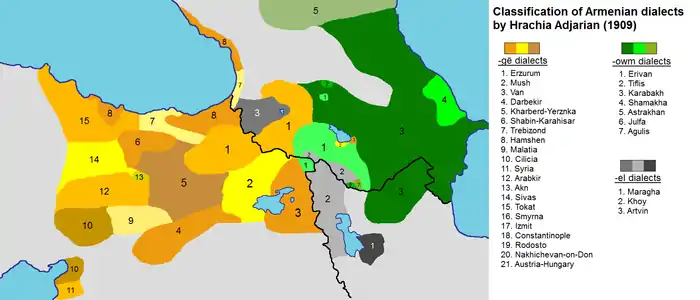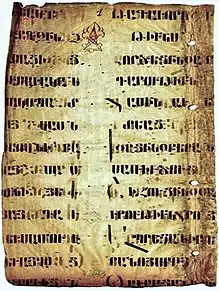Eastern Armenian
Eastern Armenian (Armenian: արևելահայերեն arevelahayeren) is one of the two standardized forms of Modern Armenian, the other being Western Armenian. The two standards form a pluricentric language.
| Eastern Armenian | |
|---|---|
| արևելահայերեն arevelahayeren | |
| Native to | Armenian Highlands, Armenia, Artsakh, Iran, Georgia, Russia, Ukraine, Central Asia |
Native speakers | (undated figure of 4.3 million)[1] |
Modern Armenian
| |
| Armenian alphabet (virtually always in the reformed orthography, except in Iran) | |
| Language codes | |
| ISO 639-3 | – |
| Glottolog | nucl1235 |
 Map of the Armenian dialects in early 20th century: -owm dialects, corresponding to Eastern Armenian, are shown in green. | |
 |
| History of the Armenian language |
|---|
|
|
Armenian alphabet Romanization of Armenian |
Eastern Armenian is spoken in Armenia, Artsakh, Russia, as well as Georgia, and by the Armenian community in Iran. Although the Eastern Armenian spoken by Armenians in Armenia and Iranian-Armenians are similar, there are pronunciation differences with different inflections. Armenians from Iran also have some words that are unique to them. Due to migrations of speakers from Armenia and Iran to the Armenian diaspora, the dialect is now very prominent in countries and regions where only Western Armenian was used. Eastern Armenian is based on the Yerevan dialect.
Official status and recognition
Eastern Armenian is, for the most part, mutually intelligible by educated or literate users of Western Armenian – and vice versa. Conversely, semi-literate or illiterate users of lower registers of either variety may have difficulty understanding the other.
The official language, according to law, of Armenia is an unspecified "Armenian".[2] In practice, however, Eastern Armenian is the de facto, day-to-day common language of Armenia. For example, commercial translations are generally completed in Eastern Armenian.
Until 2018, both varieties shared the same ISO 639-3 code: hye. However, on 23 January 2018, a code specifically for Western Armenian was added to ISO 639-3: hyw. (The previous code under ISO 639-1 was hy.)
The Armenian Wikipedia is predominantly composed of Eastern Armenian content. As a result of the amendment to ISO 639-3, a campaign to create a separate Wikipedia for Western Armenian has been approved. This has resulted in separate Wikipedia sites for Eastern Armenian and Western Armenian.
Phonology
Monophthongs
Eastern Armenian has six monophthong vowel sounds.
| Front | Central | Back | ||
|---|---|---|---|---|
| Unrounded | Rounded | |||
| Close | i ի i |
u ու u | ||
| Mid | ɛ ե, է[3] e, ē |
ə ը ë |
ɔ ո, օ[3] o, ò | |
| Open | ɑ ա a |
|||
Consonants
This is the Eastern Armenian Consonantal System using symbols from the International Phonetic Alphabet (IPA), followed by the corresponding Armenian letter in parentheses.
| Bilabial | Labiodental | Alveolar | Post- alveolar |
Palatal | Velar | Uvular | Glottal | ||
|---|---|---|---|---|---|---|---|---|---|
| Nasal | m (մ) | n (ն) | ⟨ŋ⟩ | ||||||
| Stop | aspirated | pʰ (փ) | tʰ (թ) | kʰ (ք) | |||||
| voiceless[4] | p (պ) | t (տ) | k (կ) | ||||||
| voiced | b (բ) | d (դ) | ɡ (գ) | ||||||
| Affricate | aspirated | tsʰ (ց) | tʃʰ (չ) | ||||||
| voiceless | ts (ծ) | tʃ (ճ) | |||||||
| voiced | dz (ձ) | dʒ (ջ) | |||||||
| Fricative | voiceless | f (ֆ) | s (ս) | ʃ (շ) | χ (խ) | h (հ, յ)[5] | |||
| voiced | v (վ, ւ, ու, ո)[6] | z (զ) | ʒ (ժ) | ʁ (ղ) | |||||
| Approximant | ⟨ʋ⟩ | ɹ~ɾ (ր)[7] | j (յ, ե, ի, է)[8] | ||||||
| Tap | |||||||||
| Trill | r (ռ) | ||||||||
| Lateral | l (լ) | ||||||||
The phonology of Eastern Armenian preserves the Classical Armenian three-way distinction in stops and affricates: one voiced, one voiceless and one aspirated. Compare this to the phonology of the Western Armenian language, which has kept only a two-way distinction: one voiced and one aspirated. (See the Differences in Phonology from Classical Armenian in the Western Armenian language article for details.)
A few exceptional Eastern Armenian words contain voiced stop letters pronounced as voiceless aspirated stops, like Western Armenian. For instance, թագավոր (king) is [tʰɑkʰɑˈvɔɾ], not [tʰɑɡɑˈvɔɾ]; other examples are ձիգ, ձագ, կարգ, դադար, վարագույր.
Orthography
The Eastern Armenian language is written using either Traditional Armenian Orthography or Reformed Armenian Orthography. The controversial reformed orthography was developed during the 1920s in Soviet Armenia and is in widespread use today by Eastern Armenian speakers in Armenia and those in the diaspora that are from Armenia. Eastern Armenian speakers in Iran continue to use the traditional orthography. Nevertheless, writings of either form are mutually intelligible, since the difference between the two orthographies is not large.
Morphology
Pronouns
| Personal pronouns | |||||||
|---|---|---|---|---|---|---|---|
| singular | plural | ||||||
| 1st person | 2nd person | 3rd person | 1st person | 2nd person | 3rd person | ||
| nominative | ես (es) | դու (du) | նա (na) | մենք (menkʿ) | դուք (dukʿ) | նրանք (nrankʿ) | |
| genitive | իմ (im) | քո (kʿo) | նրա (nra) | մեր (mer) | ձեր (jer) | նրանց (nrancʿ) | |
| dative | ինձ (inj) | քեզ (kʿez) | նրան (nran) | մեզ (mez) | ձեզ (jez) | նրանց (nrancʿ) | |
| accusative | ինձ (inj) | քեզ (kʿez) | նրան (nran) | մեզ (mez) | ձեզ (jez) | նրանց (nrancʿ) | |
| ablative | ինձնից (injnicʿ), ինձանից (injanicʿ) | քեզնից (kʿeznicʿ), քեզանից (kʿezanicʿ) | նրանից (nranicʿ) | մեզնից (meznicʿ), մեզանից (mezanicʿ) | ձեզնից (jeznicʿ), ձեզանից (jezanicʿ) | նրանցից (nrancʿicʿ) | |
| instrumental | ինձնով (injnov), ինձանով (injanov) | քեզնով (kʿeznov), քեզանով (kʿezanov) | նրանով (nranov) | մեզնով (meznov), մեզանով (mezanov) | ձեզնով (jeznov), ձեզանով (jezanov) | նրանցով (nrancʿov) | |
| locative | ինձնում (injnum), ինձանում (injanum) | քեզնում (kʿeznum), քեզանում (kʿezanum) | նրանում (nranum) | մեզնում (meznum), մեզանում (mezanum) | ձեզնում (jeznum), ձեզանում (jezanum) | նրանցում (nrancʿum) | |
Armenian has T-V distinction, with դու, քո, քեզ used informally and capitalized Դուք, Ձեր, Ձեզ as the polite forms.
Nouns
Eastern Armenian nouns have seven cases, one more than Western Armenian. They are: nominative (subject), accusative (direct object), genitive (possession), dative (indirect object), ablative (origin), instrumental (means) and locative (position). Of the seven cases, the nominative and accusative, with exceptions, are the same, and the genitive and dative are the same, meaning that nouns have mostly five distinct forms for case. Nouns in Armenian also decline for number (singular and plural), but do not decline for gender (i.e. masculine or feminine).
Declension in Armenian is based on how the genitive is formed. There are several declensions, but two are the most used (genitive in i, and genitive in u):
| Ablative | դաշտից /dɑʃˈtit͡sʰ/ |
դաշտերից /dɑʃtɛˈɾit͡sʰ/ |
/ɡɑˈɾut͡sʰ/ | /ɡɑɾinɛˈɾit͡sʰ/ |
| Instrumental | դաշտով /dɑʃˈtɔv/ |
դաշտերով /dɑʃtɛˈɾɔv/ |
/ɡɑˈɾɔv/ | /ɡɑɾinɛˈɾɔv/ |
| Locative | դաշտում /dɑʃˈtum/ |
դաշտերում /dɑʃtɛˈɾum/ |
/ɡɑˈɾum/ | /ɡɑɾinɛˈɾum/ |
Two notes:
First, notice that the Ablative form in Eastern Armenian is /-it͡s/, where it is -ê in Western Armenian:
Abl.sg WA karê/EA /ɡɑɾut͡sʰ/
Second, notice that in Western Armenian, the plural forms followed the u-declension, while in Eastern Armenian the plural forms follow the i-declension:
Gen.pl WA karineru/EA /ɡɑɾinɛˈɾi/
Articles
Like some other languages such as English, Armenian has definite and indefinite articles. The indefinite article in Eastern Armenian is /mi/, which precedes the noun:
mi ɡiɾkʰ ('a book', Nom.sg), /mi ɡɾkʰi/ ('of a book', Gen.sg)
The definite article is a suffix attached to the noun, and is one of two forms, either /-ə/ or /-n/, depending on whether the final sound is a vowel or a consonant, and whether a following word begins with a vowel or consonant:
/mɑɾdə/ ('the man', Nom.sg)
/ɡɑɾin/ ('the barley' Nom.sg)
but:
/sɑ mɑɾdn ɛ/ ('This is the man')
/sɑ ɡɑɾin ɛ/ ('This is the barley')
Adjectives
Adjectives in Armenian do not decline for case or number, and precede the noun:
/lɑv ɡiɾkʰə ('the good book', Nom.sg)
/lɑv ɡɾkʰi ('of the good book', Gen.sg)
Verbs
Verbs in Armenian are based on two basic series of forms, a "present" form and an "imperfect" form. From this, all other tenses and moods are formed with various particles and constructions. There is a third form, the preterite, which in Armenian is tense in its own right, and takes no other particles or constructions. (See also Armenian verbs and Eastern Armenian verb table for more detailed information.)
The present tense in Eastern Armenian is based on two conjugations (a, e). In Eastern Armenian, the distinct conjugations in e and i merged as e.
| /linɛl/
|
/siɾɛl/
|
/kɑɾdɑl/
| |
| present participle | /siɾum/ | /kɑɾdum/ | |
| /jɛs/ (I) | /ɛm/ | /siɾɛm/ | /kɑɾdɑm/ |
| /du/ (you. sg) | /ɛs/ | /siɾɛs/ | /kɑɾdɑs/ |
| /nɑ/ (he/she/it) | /ɛ/ | /siɾi/ | /kɑɾdɑ/ |
| /mɛnkʰ/ (we) | /ɛnkʰ/ | /siɾɛnkʰ/ | /kɑɾdɑnkʰ/ |
| /dukʰ/ (you.pl) | /ɛkʰ/ | /siɾɛkʰ/ | /kɑɾdɑkʰ/ |
| /nɾɑnkʰ/ (they) | /ɛn/ | /siɾɛn/ | /kɑɾdɑn/ |
The present tense (as we know it in English) is made by adding the present tense of linel after the present participle form of the verb:
jɛs kɑɾdum ɛm ɡiɾkʰə/ (I am reading the book)
jɛs siɾum ɛm ɑjd ɡiɾkʰə/ (I love that book)
See also
References
- Armenian (Lebanon) at Ethnologue (10th ed., 1984). Note: Data may come from the 9th edition (1978).
- Law on Language, Armenia
- The choice of Armenian symbol depends on the vowel's context in the word. See the Orthography section below for details.
- “In some publications, the voiceless plosives are also defined as ejectives or glottalised. Glottalised plosives occur in various Armenian dialects and can also be found in the Eastern Armenian vernacular based on the Yerevan dialect, but according to normative grammars, SMEA [Standard Modern Eastern Armenian] shows no glottalised voiceless plosives.” Jasmine Dum-Tragut. Armenian: Modern Eastern Armenian. London Oriental and African Language Library, 2007, issn 1382-3485; p. 17
- In traditional orthography, /h/ is written in one of two ways, depending on its context. In reformed orthography, /h/ is written only one way, ⟨հ⟩.
- In traditional orthography, /v/ is written in one of four ways, depending on its context. In reformed orthography, /v/ is written only one way, ⟨վ⟩.
- In practice, only Iranian-Armenians say [ɹ]; Eastern Armenians from Armenia have shifted the Classical Armenian [ɹ] (ր) to [ɾ].
- In traditional orthography, /j/ is written in a number of ways, depending on its context. In reformed orthography, /j/ is written only one way, ⟨յ⟩.
Bibliography
- Dora Sakayan. (2007) Eastern Armenian for the English-speaking World. A Contrastive Approach (with CD-ROM). Yerevan State University Press. ISBN 5808408903
External links
Eastern Armenian Online Dictionaries
- Nayiri.com (Library of Armenian dictionaries):
- Armenian Explanatory Dictionary (ՀԱՅԵՐԷՆ ԲԱՑԱՏՐԱԿԱՆ ԲԱՌԱՐԱՆ) by Stepan Malkhasiants (about 130,000 entries). Written in traditional Armenian orthography. One of the definitive Armenian dictionaries.
- Explanatory Dictionary of Contemporary Armenian (ԺԱՄԱՆԱԿԱԿԻՑ ՀԱՅՈՑ ԼԵԶՎԻ ԲԱՑԱՏՐԱԿԱՆ ԲԱՌԱՐԱՆ) published by the Armenian SSR Academy of Sciences between 1969 and 1980. In Eastern Armenian, reformed orthography (about 125,000 headwords).
- Modern Armenian Explanatory Dictionary (ԱՐԴԻ ՀԱՅԵՐԵՆԻ ԲԱՑԱՏՐԱԿԱՆ ԲԱՌԱՐԱՆ) by Edward Aghayan (about 135,600 headwords). In Eastern Armenian and Soviet Armenian orthography.
- Armenian Language Thesaurus (ՀԱՅՈՑ ԼԵԶՎԻ ՀՈՄԱՆԻՇՆԵՐԻ ԲԱՌԱՐԱՆ) by Ashot Sukiasyan (about 83,000 entries). In Eastern Armenian and Soviet Armenian orthography.
